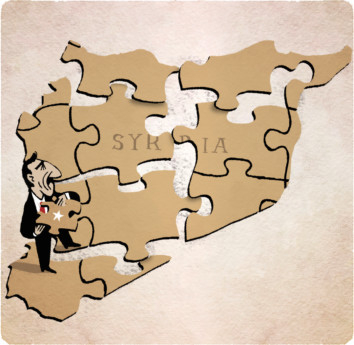
Four years after the eruption of the Syrian uprising, which quickly turned from peaceful anti-government demonstrations to bloody confrontations between the regime and various opposition groups, there are still no decisive winners. But on the ground, new realities are emerging as the balance of power shifts from one side to the other — preparing the scene for a de facto partition.
New areas of influence are being carved out as regime forces retreat from key areas in the north, east and south. The loss of the strategic governorate of Idlib in the northwest few weeks ago has dealt a heavy blow to the regime, whose forces have withdrawn to the west in order to defend the Syrian coastline. The force to reckon with in that region is a coalition of Islamist militias, called Army of Conquest, led by Jabhat Al Nusra. By taking Idlib and Jisr Al Shugour, the coalition now threatens Latakia, Homs and Aleppo.
In the eastern Syrian desert, Daesh (the self-proclaimed Islamic State of Iraq and the Levant) militants were able to march into Palmyra facing little resistance from government forces. The takeover of this strategic city opens the way to Damascus and Homs and brings the militants closer to the Hauran plain in the south, especially Suwayda and Jabal Al Arab, the historical base for Syria’s Druze. Most importantly, it connects this part of Syria to Daesh’s capital in Raqqa in the east.
And in recent days, Syria’s Kurdish forces, also known as YPG, carried out swift attacks in the Raqqa governorate, capturing the strategic town of Tal Abyad from Daesh in addition to other villages previously under the control of the militants. The YPG takeover forced Arab and Turkmen residents to flee to Turkey. The latter expressed concern over YPG’s sudden expansion along Syrian-Turkish borders. Officials representing the Syrian National Coalition (SNC) accused Syria’s Kurds of attempting to carve out a Kurdish canton for themselves.
Daesh militants finally reacted to the YPG’s recent gains by waging a surprise attack on Kobani, on the Turkish border, and another on Hassakeh, which is still held by government troops. The outcome of these battles will determine who will finally control this remote part of Syria.
In the south, the Free Syrian Army (FSA) and Jabhat Al Nusra launched a major attack, named ‘Southern Storm’, to liberate the city of Daraa along the Jordan-Syria borders. If they succeed then all of southern Syria will be in the hands of FSA and Jabhat Al Nusra, opening the way to the southern Damascus countryside through the international highway and by way of Al Qunaitra where skirmishes continue.
The regime, it appears, has come to the conclusion that it can no longer defend regions far away from the capital and the coastal plain. Its forces, along with Hezbollah fighters, have managed to maintain control of the Al Qalamoun mountain range between Syria and Lebanon. This is an important pass to the coastal areas and Homs. The opposition will find it difficult to penetrate through these lines.
In reality, Syria is being divided into areas of influence, cantons and quasi states among four main opposition groups. The Conquest Army is in control of northwestern Syria and will attempt to evict government forces from Aleppo, before attempting to push into the coastal plain. The Syrian army, along with Iranian Republican Guard and foreign fighters, will make sure that the opposition does not gain any ground in the coastal region.
Newly-acquired areas of influence
The fighting between Syria’s Kurds and Daesh militants will end up in dividing northeastern and eastern Syria between them; in effect creating the Kurdish canton with land links to Iraq’s Kurdistan. On the other hand, Daesh will defend its capital in Raqqa and will keep control of most of eastern Syria all the way to Palmyra and may even challenge FSA and Jabhat Al Nusra in Suwayda. And the latter will try to retain control of southern Syria with access to the Golan Heights and the Damascus countryside in the south and east.
Unless the regime implodes, it will defend the capital, Al Qalamoun, Homs and the coastal plain — in effect, its last line of defence. One thing that will play in its favour is the fact that opposition groups will fight amongst themselves to maintain newly-acquired areas of influence. Daesh will fight on two fronts — against the Kurds in the east and against the FSA-Jabhat Al Nusra alliance in the south. The Army of Conquest will focus on liberating Aleppo in the coming weeks, but it will also face Daesh fighters who are also trying to extend their control into the city and its environs.
Other players — in addition to Iran, Russia, Turkey, Saudi Arabia and Qatar — that could be drawn in include Israel, which will make sure that the Golan side of Syria does not constitute a new threat, and Jordan, which will feel uneasy that Jabhat Al Nusra, an affiliate of Al Qaida, will be in control of southern Syria.
In any case, Syria is going through de facto partition, but the lines will keep shifting and areas will change hands, for many weeks to come. The regime will retreat, but it will defend its red lines vigorously and tenaciously.
Osama Al Sharif is a journalist and political commentator based in Amman.












